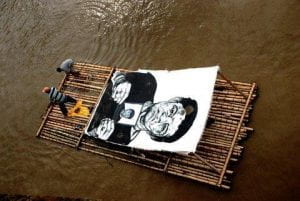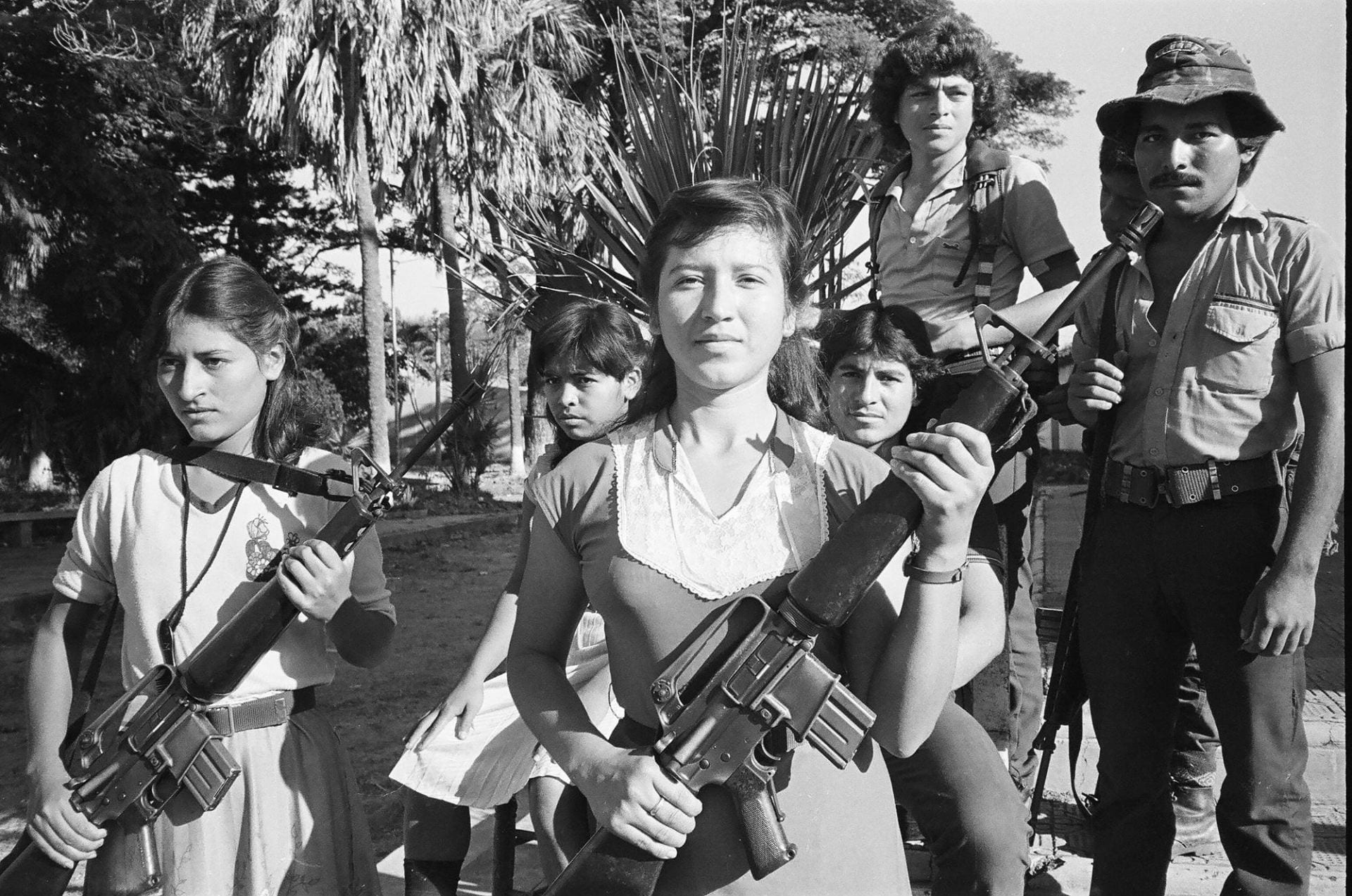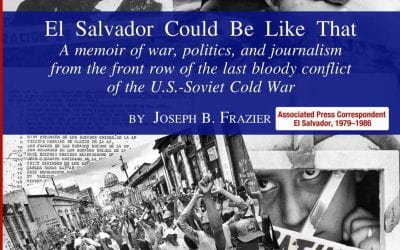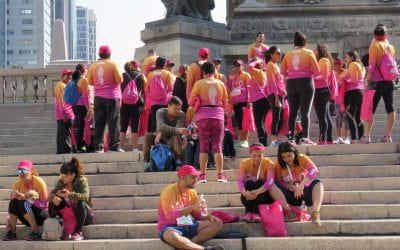
Artist Gabriel Posada set rafts adrift in the Cauca River with Vinyl paint images of the disappeared in ” Magdalenas by the Cauca.” Photo by Maria Victoria Uribe
Colombia has been a country with amnesia for a long time.
The country has been at war—a social catastrophe since 1948, sparked by the murder of the revered liberal leader Jorge Eliécer Gaitán. Although his death took place in Bogotá, during the following 16 years Liberals and Conservatives waged a war mostly in the countryside that took 250,000 lives. Despite deaths of this magnitude, for decades no one talked about victims nor mentioned the word “memory.”
It was not until 2005, after the enactment of the Law of Justice and Peace, that these words appeared in the public Colombian vocabulary. If we analyze the texts written about La Violencia or look at the countless photographs taken in towns and villages during those years, we see many dismembered corpses, but we do not find victims. This is a tremendous paradox that underscores how this Violencia, excessive and fratricidal, remained buried along with its crimes, which were never brought to justice. The country shrouded itself in a mantle of impunity and opted to bury its disgraceful past. And from 1980 on, this unresolved violence continued in the form of drug trafficking and paramilitarism. If societies do not examine themselves through the mirror of memory, the cycles of violence repeat themselves.
REPRESENTATIONS OF THE DISAPPEARED
In Colombia, murdered bodies are often tossed into a river to conceal the crimes and do away with the evidence; stories about this disposal method date back to the 1950s. During the past thirty years, some communities along the Cauca River have become accustomed to seeing mutilated bodies float by, headed downriver from towns where dealings are resolved through bullets or machetes. To this day, in the northern part of the Valle department (the Colombian word for “state”), which has been under the domination of the regional drug cartel, mutilated bodies sometimes are still seen floating down the river. As so many other rivers in Colombia, the Cauca is a liquid tomb through which countless bodies of the victims of the armed conflict have journeyed toward anonymity and forgetting.
In the face of such a desolate panorama of chronic violence—which is not yet over—art has managed to extend a conciliatory bridge between the representation of the conflict and its unrepresentable suffering. Several Colombian artists have sought to represent violence through different media. Using video, performance and photography, they have sought to give shape to what cannot be represented, has no expression, what we anthropologists and historians have been incapable of putting into words. One of the recurrent themes of these artists has been the void that the disappeared leave behind.
In her book Revolt, She Said, literary critic Julia Kristeva observed how artists mediate violence through their work. In appropriating what is not their own, artists manage to build a bridge between the self and the world. This alchemy is a delicate one, whose worth we tend to underestimate. It is an act of creation that is located precisely in that space that separates the individual from the world, a privileged space in which metaphor, metonymy and other figures of speech are all called into play. The role of the artist is not to make a faithful copy of reality. It is to give a form to our attitude in the face of this reality.
In a bend of the Cauca River, just by the town of Marsella, bodies and other objects tend to get stuck as they come floating down the river. A woman living there, Esperanza, also called “death lover” (“la enamorada de los muertos”), worked as a secretary in the small hamlet of El Alto during the chilling period of the narco-paramilitary violence. Like Hecuba and Medea in Greek mythology, Esperanza disobeyed orders from local killers not to retrieve the bodies that came floating down the river so they could be buried. Esperanza told me that she rescued the bodies because she felt a moral obligation to these people and their families. She recounted how she always made the effort to register each death and any appropriate details in an archive she was assembling: “I couldn’t let those bodies just float down the river; I knew that behind every body was a mother or a wife crying, hoping that perhaps someone would rescue the body and bury it. Moreover, it seemed to me this was the least I could do as a gesture of Christian charity. I put a lot of effort into the writing of each death certificate; I took notice of every detail, the brand of clothing, any particular characteristics that would allow families to identify them.”
This humanitarian labor was constantly threatened by lack of support from the municipality; indeed, she received overt orders from her bosses to stop retrieving the bodies. Because of frequent episodes of intimidation and pressure, Esperanza quit her post in the municipal administration in 2001. Her husband was a fisherman and she often accompanied him on his fishing trips. When she would see a body floating down the river, she would take it out with her own hands and would advise the authorities, obliging them to record and process the death. As a result, she received death threats and constant pressure to abandon her rescue missions. The threats continued until 2005, when her riverside home was burnt to the ground. She was warned that if she did not leave her neighborhood, the next attack would be directly against her life or that of her husband. She left and went to live far from the riverbanks.
The Marsella cementery was recently declared historic and architectural patrimony of the nation by the Colombian Minister of Culture. After the declaration, the Beautification Society of the town ordered the tombs painted. This procedure erased the data that had been handwritten on the tombs of more than four hundred people, who had been buried as “NN” (“No Name”) with only the information about their gender and the year the body reached Marsella. Likewise, no one thought of making a map that would help locate and identify the remains. This act of painting over the information transformed the bodies into unidentifiable beings, an act that created a double disappearance.
As an act of reparation for what had transpired in Marsella and so many other towns along the Cauca River, the artist Gabriel Posada conceived an ephemeral work known as “Magdalenas by the Cauca,” a work of historical memory funded by a Culture Ministry fellowship. Posada designed some rafts from tropical guadua bamboo cane and added sails. On each sail, he used vinyl paint to depict, from remaining photos, the faces of some of the disappeared victims. Posada set the rafts adrift in the Cauca River, carrying along the images of men and women whose fate had been erased. The intent of the performance was to cleanse the stamp of the deaths that the Rio Cauca bore for having received so many mutilated bodies over so many years. The artist recreated this moving spectacle on several occasions, ephemeral art since the rafts crashed against the riverbanks to eventually become shipwrecked further down the river. The performance included the victims of the Trujillo massacre—actually a series of murders that took place along the Cauca River from 1988 and 1994— and was witnessed by the fishermen who lived along the riverbanks.
Another work of art that alludes to the disappeared is artist Clemencia Echeverry’s The Bier’s Funeral Song (Treno Canto Fúnebre). By means of a video installation, Echeverry shows the invisible destruction that has characterized forced disappearances in Colombia. While we observe the turbulent and dark waters of the Cauca River on a double screen, the room is invaded by a soundtrack of the heartrending screams of loved ones who search for their vanished loved ones. Through this blending of image and sound, the artist performs a delicate alchemy to appropriate some sounds that are heard on both sides of the river and, by association, creates an echo in the psyche of the viewer as in the psyches of so many other Colombians.
The recent history of Colombia is filled with voices and sounds that recall the violence—sounds like the cries of “viva” (long live! cries of affirmations) and “down with!” boos for each political party during the 1950s; or the clanking of chains on the truck that set off during the night to pick up members of the Liberal party and disappear them; or the melancholy, deep sound of a deer horn that was played to warn about the arrival of “chusma,” a riffraff mob from which one could anticipate the worst. More recently, there’s the strident sound of motorboats that have come to form part of the repertory of horror for the inhabitants along the Atrato River or the Great Swamp of Santa Marta because it recalls the arrival of paramilitary forces; or the hushed cries of those who search for their relatives disappeared in the whirling river.
Today, in the midst of the general clamor for peace that accompanies the negotiations between the Colombian government and the FARC guerrilla group, we still imagine hearing voices of men and women that cannot be identified because they do not form part of the national narrative. They are voices without a body; they are the No-Names, the disappeared whose faces watch us without asking questions. Voices that belong to those who are invisible to the society, whose bodies disappeared and whose remains lie piled up on the bottom of the rivers.
María Victoria Uribe is an anthropologist at the Universidad del Rosario in Bogotá, Colombia. Her current research involves a comparative analysis of political violence in Sri Lanka, Colombia, and Northern Ireland. She is the author of Anthropologie de l’Inhumanité (2004).
Related Articles
El Salvador Could Be Like That: A Memoir of War, Politics, and Journalism from the Front Row of the Last Bloody Conflict of the U.S.-Soviet Cold War
“There are no just wars. There are only just causes.” I was sitting in the modest home of a former FMLN guerrilla woman in a rural village in the northeastern corner of El Salvador. It was 2001, and I was nearing the end of my second year-long stint in this small Central American nation, interviewing more than 200 Salvadorans, mostly from rural areas, about their experiences during the civil conflict of the 1980s. …
First Take: Memories and Their Consequences
I visited the Museo de la Memoria y los Derechos Humanos in Santiago, Chile, two years ago. It was a heart-rending experience. To enter the museum, I moved through a stark and subterranean passage and found myself in a somber space of transition. There, a wall of photographs transported me back in time—long ago in a messy graduate student lounge in Cambridge, Massachusetts, four of us stood in shock …
An Exploration of the Mexican Health Care System
The recent creation of Seguro Popular—a governmental program granting basic health services to millions of Mexicans previously uninsured—has newly enabled thousands of Mexican women afflicted with breast cancer to access treatment. With the growing prevalence of breast cancer survivors, the question now arises of how best to maintain their health and address their needs. …





